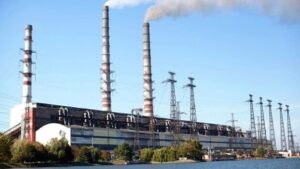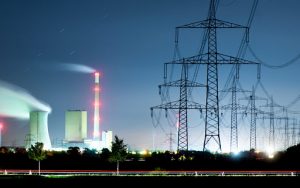
DTEK Energo’s thermal power plants have increased electricity production by 28% over the past four months compared to the same period in 2022, the energy holding company said in a press release on Wednesday.
“In August, when consumption held at record highs for summer due to the heat wave, power engineers generated 35% more electricity into the energy system than in August last year,” the company said.
In total, in January-August 2023, the company’s thermal power plants released about 9.9 billion kWh of electricity, which is equivalent to the average consumption of about 3.3 million households during the year.
“Power engineers do their best to, on the one hand, repair, restore and prepare the plants for maximum load in the fall and winter period, on the other hand, to reliably maintain and insure the energy system during other peak periods as well. For this purpose, just last week we put two power units of our TPPs into operation after repair, with a total capacity of almost 400 MW,” DTEK Energy CEO Ildar Saleev was quoted in the press release.
DTEK Energy currently operates six of the nine TPPs remaining in the unoccupied territory of Ukraine: Burshtynska, Dobrotvirska and Ladyzhynska TPPs (DTEK Zakhidenergo), Prydniprovska and Kryvorizka TPPs (DTEK Dniproenergo) and Kurakhovska TPP (Vostokenergo LLC).

Electricity production in the Integrated Power System (IPS) of Ukraine in January-September 2021 grew by 6.2% (by 6.702 billion kWh) compared to the same period in 2020, to 114.375 billion kWh, according to data from the Ministry of Energy.
According to the calculations of Interfax-Ukraine, nuclear power plants (NPPs) in January-September 2021 increased electricity generation by 9.1%, to 61.946 billion kWh. In particular, production at the Zaporizhia NPP amounted to 25.382 billion kWh (a rise of 26.3% versus January-September 2020), Yuzhnoukrainsk NPP – 13 billion 237.5 million kWh (1.8% less), Rivne NPP – 14.474 billion kWh (0.5% more), Khmelnytska NPP – 8.852 billion 852.1 million kWh (0.6% more).
Thermal power plants (TPPs), as well as combined heat and power plants (CHPPs) and cogeneration plants reduced their output by 4.9%, to 33.308 billion kWh, including generating companies, TPPs increased production by 2.4%, to 26.732 billion kWh, while CHP and cogeneration plants decreased by 26.2%, to 6.575 billion kWh.
Hydro and pumped storage power plants (HPPs and PSPPs) increased production by 45.4%, to 8.139 billion kWh, while block stations decreased by 12.8%, to 1.24 billion kWh.
Electricity production by alternative sources (wind farms, solar power plants, biomass) increased by 10%, to 9.743 billion kWh.
The share of nuclear power plants in the structure of electricity production amounted to 54.2% (in January-September 2020 it was 52.7%), thermal power plants, thermal power plants and cogeneration plants – 29.1% (32.5%), hydroelectric power plants and pumped storage power plants – 7.1% (5.2%), block stations – 1.1% (1.3%), alternative sources – 8.5% (8.2%).
In September 2021, electricity production in the IPS of Ukraine grew by 4.1% (by 457.7 million kWh) compared to the same month last year, to 11.735 billion kWh.
In addition, the supply of heat energy in January-September 2021 rose by 12.1% (by 1.604 million Gcal) compared to the same period last year, to 14.833 million Gcal.

Electricity production by all power plants of state-owned enterprise Energoatom in January-October 2020 decreased by 6% (by 4.057 billion kWh), to 63.214 billion kWh compared to the same period in 2019.
According to the company’s report, the target for electricity production for the specified period was exceeded by 2.8%.
The power plants of the state-owned enterprise supplied 59.059 billion kWh of electricity versus 63.170 billion kWh in January-October 2019.
The share of Energoatom in the total structure of electricity production in the country amounted to 52.8%, which is by 0.3 percentage points less than in the ten months last year.
The volume of capital investment use amounted to UAH 7.091 billion versus UAH 11.293 billion in January-October 2019, financing of capital investments some UAH 7.404 billion versus UAH 12.544 billion.
According to the results of the reporting period, Energoatom transferred UAH 8.980 billion to the budgets of all levels, insurance payments amounted to UAH 2.593 billion.
The installed capacity utilization factor of the enterprise amounted to 62.2%, which is 4.3 percentage points less than in January-October 2019. At the same time, the coefficient of readiness to bear nominal electric load amounted to 71.8%, which is 4 percentage points more than in the ten months of 2019.

Electricity production in the united energy system of Ukraine in January-October 2020 decreased by 5.4% (by 6.888 billion kWh) compared to the same period in 2019, to 119.819 billion kWh, the Ministry of Energy has told Interfax-Ukraine.
Nuclear power plants (NPP) for the ten months of this year reduced electricity generation by 6% compared to the same period last year, to 63.030 billion kWh. In particular, production of electricity at Zaporizhia NPP amounted to 22.248 billion kWh (29.6% less compared to January-October 2019), Yuzhnoukrainsk NPP some 15.126 billion kWh (6.9% more), Rivne NPP some 15.929 billion kWh (6.5% more), Khmelnytsky NPP some 9.727 billion kWh (up by 52.5%).
Thermal power plants (TPP), as well as combined heat and power plants (CHPP) and cogeneration plants reduced their output by 16.2%, to 39.317 billion kWh. In particular, the generating companies of TPPs reduced production by 23.7%, to 29.544 billion kWh, while CHPP and cogeneration plants increased it by 19.3%, to 9.774 billion kWh.
Hydro power plants and pumped storage power plants reduced production by 6.1%, to 6.237 billion kWh, and block stations increased by 8.2%, to 1.601 billion kWh.
Electricity production by non-traditional sources (wind power plants, solar power plants, biomass) increased by 2.1 times, to 9.634 billion kWh.
The share of nuclear power plants in the structure of electricity production amounted to 52.6%, TPPs, CHPPs and cogeneration plants 32.8%, hydro power plants and pumped storage power plants 5.2%, block stations 1.3%, alternative sources 8%.